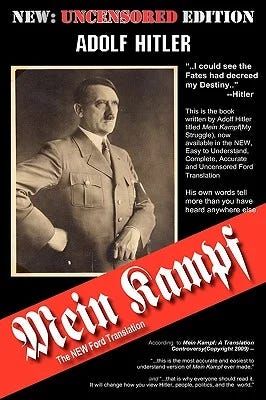A Cautious Examination Between Mark Carney’s Book, “Values” and Adolf Hitler’s Mein Kampf:
Rhetorical and Structural Parallels
Despite being written by individuals from vastly different moral and historical contexts, Mark Carney’s Values: Building a Better World for All (2021) and Adolf Hitler’s Mein Kampf (1925) both utilize certain common rhetorical techniques and structural elements often found in ideological or reformist literature. These similarities do not indicate any equivalence of message, ethics, or worldview, but rather illustrate how persuasive arguments often rely on shared narrative frameworks.
Crisis as a Catalyst for Reform
Carney’s Values: The book begins by identifying global crises—such as the 2008 financial collapse, climate change, and the COVID-19 pandemic—as symptoms of a moral failure in capitalism. These are used to justify the need for an economic and ethical transformation.
Hitler’s Mein Kampf: also begins with a narrative of crisis—Germany’s defeat in WWI, the Treaty of Versailles, and national humiliation—which he presents as justification for radical political and racial reform.
Similarity: Both authors use crisis to frame their call to action, a common technique in persuasive writing that seeks to mobilize readers toward change.
Personal Experience as a Moral Lens
Carney: Leverages his background as a central banker to lend credibility to his analysis. His insider experience is used to critique the existing system and propose reforms.
Hitler: Similarly relies on autobiographical elements to give authority to his vision. His struggles and experiences in Vienna and during WWI are used to justify his later political positions.
Similarity: Both books position the author’s personal history as evidence of insight, building a narrative of the author as a witness to system failure.
Moral Framing of Economic and Social Structures
Carney: Argues that markets must be grounded in social values—like solidarity, responsibility, and sustainability—and warns against “market fundamentalism” divorced from ethics.
Hitler: Frames economics and politics as subordinate to a moral and racial worldview, proposing a vision of national rebirth based on ethnic purity and unity.
Similarity: Both authors integrate morality into their economic or political visions, though Carney advocates for inclusion and equity, while Hitler’s framework is exclusionary and supremacist. The technique—linking values to system change—is similar; the moral content is diametrically opposed.
Appeals to a “Better” Future
Carney: Envisions a future of stakeholder capitalism that works for all, balancing market efficiency with social good.
Hitler: Envisions a reborn German Reich free from what he views as the corrupting influences of outsiders and liberal democracy.
Similarity: Both texts present a stark contrast between the flawed present and an idealized future, appealing to hope (in Carney’s case) or restoration (in Hitler’s case) to motivate readers.
Critique of Elites
Carney: Criticizes financial elites and institutions for prioritizing short-term gains over long-term social good.
Hitler: Targets political, intellectual, and ethnic elites (particularly Jews and Marxists) whom he blames for Germany’s decline.
Similarity: Each book includes an “enemy” figure blamed for systemic failure, though Carney’s critique is grounded in systemic behavior and not identity, while Hitler’s scapegoating is virulently racist and conspiratorial.
Final Notes:
Any rhetorical similarities must be understood as superficial and structural. The moral and historical differences are profound:
Carney’s work is fundamentally progressive, inclusive, and rooted in empirical data and ethical reform.
Hitler’s work is based on hate, pseudoscience, and genocidal ideology.
The comparison above shows how similar rhetorical structures can be used as a means to an ends.
The tools of persuasion may be neutral, while the message determines their legacy.
See The Similarities?






